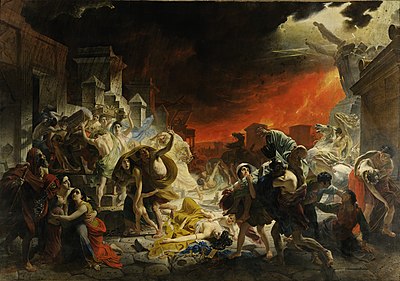This article needs additional citations for verification. (May 2012) |
 First edition title page | |
| Author | Edward Bulwer-Lytton |
|---|---|
| Language | English |
| Publisher | Richard Bentley |
Publication date | 1834 |
| Publication place | United Kingdom |
The Last Days of Pompeii is a novel written by Edward Bulwer-Lytton in 1834. The novel was inspired by the painting The Last Day of Pompeii by the Russian painter Karl Briullov, which Bulwer-Lytton had seen in Milan.[1] It culminates in the cataclysmic destruction of the city of Pompeii by the eruption of Mount Vesuvius in AD 79.

The novel uses its characters to contrast the decadent culture of 1st-century Rome with both older cultures and coming trends. The protagonist, Glaucus, represents the Greeks who have been subordinated by Rome, and his nemesis Arbaces the still older culture of Egypt. Olinthus is the chief representative of the nascent Christian religion, which is presented favourably but not uncritically. The Witch of Vesuvius, though she has no supernatural powers, shows Bulwer-Lytton's interest in the occult—a theme which would emerge in his later writing, particularly The Coming Race.
A popular sculpture by American sculptor Randolph Rogers, Nydia, the Blind Flower Girl of Pompeii (1856), was based on a character from the book.[2]
- ^ Harris, Judith (2007). Pompeii Awakened: A Story of Rediscovery. I.B. Tauris. p. 166. ISBN 978-1-84511-241-7.
- ^ "Exchange: Nydia, the Blind Flower Girl of Pompeii". exchange.umma.umich.edu. Retrieved 11 March 2020.